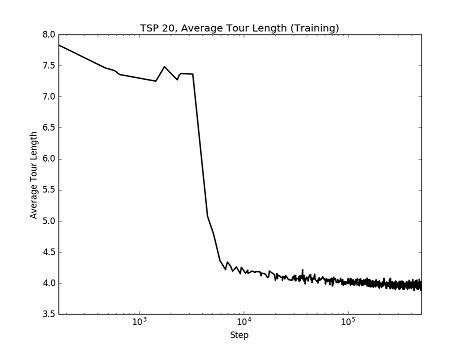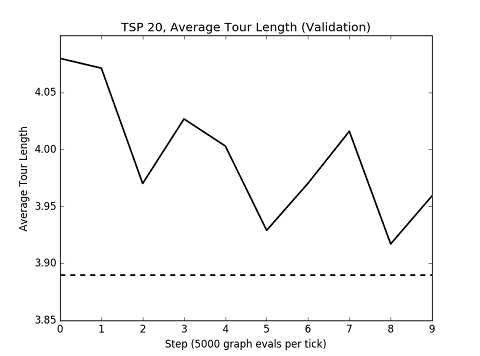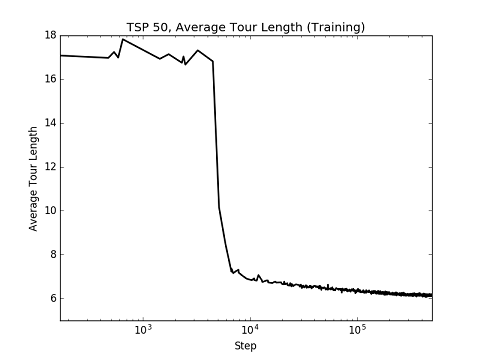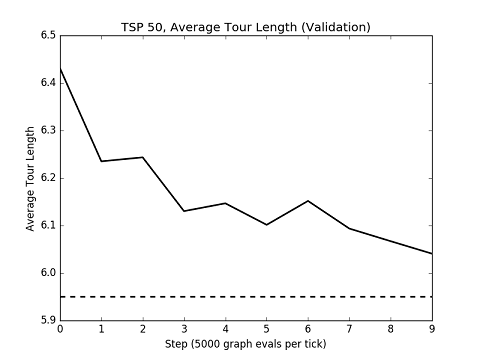neural-combinatorial-rl-pytorch
PyTorch implementation of Neural Combinatorial Optimization with Reinforcement Learning.
I have implemented the basic RL pretraining model with greedy decoding from the paper. An implementation of the supervised learning baseline model is available here. Instead of a critic network, I got my results below on TSP from using an exponential moving average critic. The critic network is simply commented out in my code right now. From correspondence with a few others, it was determined that the exponential moving average critic significantly helped improve results.
My implementation uses a stochastic decoding policy in the pointer network, realized via PyTorch's torch.multinomial(), during training, and beam search (not yet finished, only supports 1 beam a.k.a. greedy) for decoding when testing the model.
Currently, there is support for a sorting task and the planar symmetric Euclidean TSP.
See main.sh for an example of how to run the code.
Use the --load_path $LOAD_PATH and --is_train False flags to load a saved model.
To load a saved model and view the pointer network's attention layer, also use the --plot_attention True flag.
Please, feel free to notify me if you encounter any errors, or if you'd like to submit a pull request to improve this implementation.
Adding other tasks
This implementation can be extended to support other combinatorial optimization problems. See sorting_task.py and tsp_task.py for examples on how to add. The key thing is to provide a dataset class and a reward function that takes in a sample solution, selected by the pointer network from the input, and returns a scalar reward. For the sorting task, the agent received a reward proportional to the length of the longest strictly increasing subsequence in the decoded output (e.g., [1, 3, 5, 2, 4] -> 3/5 = 0.6).
Dependencies
- Python=3.6 (should be OK with v >= 3.4)
- PyTorch=0.2
- tqdm
- matplotlib
- tensorboard_logger
TSP Results
Results for 1 random seed over 50 epochs (each epoch is 10,000 batches of size 128). After each epoch, I validated performance on 1000 held out graphs. I used the same hyperparameters from the paper, as can be seen in main.sh. The dashed line shows the value indicated in Table 2 of Bello, et. al for comparison. The log scale x axis for the training reward is used to show how the tour length drops early on.
Sort Results
I trained a model on sort10 for 4 epochs of 1,000,000 randomly generated samples. I tested it on a dataset of size 10,000. Then, I tested the same model on sort15 and sort20 to test the generalization capabilities.
Test results on 10,000 samples (A reward of 1.0 means the network perfectly sorted the input):
| task | average reward | variance |
|---|---|---|
| sort10 | 0.9966 | 0.0005 |
| sort15 | 0.7484 | 0.0177 |
| sort20 | 0.5586 | 0.0060 |
Example prediction on sort10:
input: [4, 7, 5, 0, 3, 2, 6, 8, 9, 1]
output: [0, 1, 2, 3, 4, 5, 6, 7, 8, 9]
Attention visualization
Plot the pointer network's attention layer with the argument --plot_attention True
TODO
- Add RL pretraining-Sampling
- Add RL pretraining-Active Search
- Active Search
- Asynchronous training a la A3C
- Refactor
USE_CUDAvariable - Finish implementing beam search decoding to support > 1 beam
- Add support for variable length inputs
Acknowledgements
Special thanks to the repos devsisters/neural-combinatorial-rl-tensorflow and MaximumEntropy/Seq2Seq-PyTorch for getting me started, and @ricgama for figuring out that weird bug with clone()



